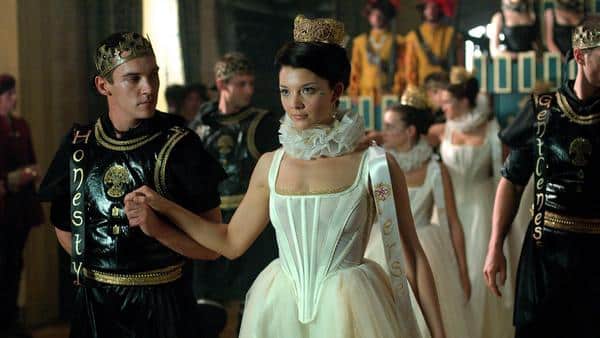
Let’s start with the context. In 1522, Cardinal Thomas Wolsey was at the height of his power, and the richest man in the land, after King Henry VIII (and Wolsey might have been richer than Henry if you count the church properties he controlled). The Holy Roman Emperor, Charles V, had sent envoys to the English court and Wolsey was allowed to host them for the Shrovetide celebrations.
[Today we tend to use the term “Mardi Gras” instead of Shrovetide, at least in the United States – to me, that does a better job of signaling that these celebrations would have been deliberately over-the-top! But I digress…]
The festivities took place over several days at Wolsey’s York Place (which would be renamed Whitehall Palace in 1530 when Wolsey fell from grace and Henry took it over…if you want to read more about Wolsey, you can click here), culminating on Shrovetide night with the Chateau Vert Tableau. Now, we usually think of a tableau as stationary – a group of models or motionless figures representing a moment from a story or from history – but this expanded to a whole scene in which the King and his companions (personifying and labeled Amorous, Nobleness, Youth, Attendance, Loyalty, Pleasure, Gentleness, Liberty, and Ardent Desire – Ardent Desire being the leader) laid siege to the Chateau Vert to rescue the eight ladies (representing the virtues of an ideal wife: Beauty, Honor, Perseverance, Kindness, Constancy, Bounty, Mercy, and Pity) who were being held captive by eight other ladies (Danger, Disdain, Jealousy, Unkindness, Scorn, Malebouche, and Strangeness).
Of course, it was a great honor to be one of the “ideal” ladies – and despite the fact that she had only recently returned from years at the French Court, Anne Boleyn was given the role of Perseverance. The Tudors series frames this event as the start of Henry’s attraction to Anne, but that is unlikely as he was in the middle of his affair with Anne’s sister Mary, who represented Kindness in the tableau….(for more on Mary, click here).
Anyway, I’m going to let eyewitness Edward Hall take it from here (I cleaned up his language a smidge – if you want the original, you can click through in the citation):
On Shrovetidesday at night, the said Cardinal to the King and ambassadors made another supper, and after supper they came into a great chamber hanged with Arras, and there was a cloth of estate, and many branches, and on every branch thirty-two torchettes of wax, and in the nether end of the same chamber was a castle, in which was a principal Tower, in which was a Cresset burning: and two other lesser Towers stood on every side, warded and embattailed, and on every Tower was a banner, one banner was of three rent hearts, the other was a lady’s hand gripping a man’s heart, the third banner was a lady’s hand turning a man’s heart. This castle was kept with ladies of strange names, the first Beauty, the second Honor, the third Perseverance, the fourth Kindness, the fifth Constancy, the sixth Bounty, the seventh Mercy, and the eighth Pity. These eight ladies had Millian gowns of white satin; every Lady had her name embroidered with gold, on their head’s cauls, and Milleia bonnets of gold, with jewels. Underneath the base fortress of the castle were other eight ladies, whose names were Danger, Disdain, Jealousy, Unkindness, Scorn, Malebouche, Strangeness; these ladies were tired like to women of Inde. Then entered eight Lords in cloth of gold caps [capes? The word is “cappes”] and all, and great mantle cloaks of blue satin; these lords were named Amorous, Nobleness, Youth, Attendance, Loyalty, Pleasure, Gentleness, and Liberty. The King was chief of this company, this company was led by one all in crimson satin with burning flames of gold, called Ardent Desire, which so moved the ladies to go over the Castle, but Scorn and Disdain said they would hold the place, then Desire said the ladies should be won and came and encouraged the knights, then the lords came to the castle (at which time without was shot a great peal of guns) and the ladies defended the castle with Rose water and Comfits, and the lords threw in Dates and Oranges, and other fruits made for pleasure but at the last the place was won, but Lady Scorn and her company stubbornly defended them with bows and balls, till the were driven out of the place and fled. Then the lords took the ladies of honor as prisoners by the hands, and brought them down, and danced together very pleasantly which much pleased the strangers, and when they had danced their fill, then all these dismissed themselves and were known: and then was there a costly banquet, and when all was done, the strangers took their leave of the King and the Cardinal and so departed into Flanders, getting to the King much commendation.
https://archive.org/details/hallschronicleco00halluoft/page/630/mode/2up?
***
If you like my posts, you’ll love my books! My Seymour Saga trilogy tells the gripping story of the short-lived dynasty that shaped the Tudor Era. Jane the Quene skews romantic, The Path to Somerset is pure Game of Thrones (without the dragons), and The Boy King is a noir coming-of-age. Get them now through Amazon, Barnes & Noble, Kobo, and Apple, or even your local independent bookstore!

(PS Already read them? Did you love them? Then please review them – even just a stars rating! It makes a huge difference in helping new readers find them and would mean the world to me!)

Be First to Comment